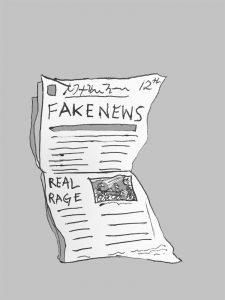Social media must curb fake news
Fake news has dominated this month’s news cycle. Almost every major media outlet has pointed fingers, profiled someone who writes or publishes fake news, compiled a list of misleading or fake sites and written column after column about what to do to prevent fake news from taking over. To me, this seems to be too little too late. Fake news proclaiming Democratic presidential candidate Hillary Clinton had a body double and President Barack Obama was moving to Canada if president-elect Donald Trump won had been shared, circulated and completely absorbed before people made their decisions about who to vote for. It is confusing, then, why major media outlets, along with Facebook and Google, are only trying to seriously grapple with how to ensure a well-informed electorate post-election.
While holding Facebook and Google accountable for allowing fake news to be spread is undeniably important, it is equally critical to figure out how to ensure media literacy in our citizens. When I first began hearing about this phenomenon, I thought I knew who was most likely to be duped by these stories.
As an internet native, I’m quite confident in my ability to distinguish between reputable news sources and non-reputable ones, real stories and satire. So, when I began hearing about the false news phenomena, I immediately pointed the finger at those who are older than me. And I’ve seen relatives and family friends who have gone from avid Fox News viewers to sharers of Infowars conspiracy theory videos on Facebook.
However, a recent study from Stanford’s Graduate School of Education evaluated middle school, high school and college students for their abilities to assess the reliability of news sources. The researchers called the results “dismaying.” According to the research, middle schoolers could not distinguish between sponsored ads and news articles, while high school students accepted photos without verifying them. Even most Stanford students failed to identify mainstream versus “fringe” sources. Clearly media literacy is not a problem among a particular age or education demographic.
In order to combat fake news, we must take an expansive approach. The threat to a well-informed citizenry does not come solely from blatantly fake news that Facebook can weed out — though this is a real problem as well. It also comes from biased sources that readers cannot evaluate as biased. Educators at all levels must give students the tools to read curiously, critically and skeptically. They should try to instill in their students a drive to assess the reliability of what they are reading.
An approach to solving the problem of fake news must also take into account that “news” is not the only way misinformation is spread. Just a couple days ago, Twitter user Adam Smoot posted two Trump tweets side by side, one from 2016 and one from 2011. This format became popular during the election when users would put two tweets from Trump side by side to show that he was being inconsistent, or even lying. Smoot’s tweet, however, was different. One of the tweets was doctored. Smoot doesn’t seem to care that it’s false, nor does he seem to have a political agenda. He later tweeted, “I’m driving people insane with rage.” To him, it’s just funny that people would believe that in 2011, Trump tweeted that burning the American flag is a peaceful protest. In just a day, despite people replying that they could not authenticate the 2011 tweet, Smoot’s deceitful, trolling post got more than 13,000 retweets and 14,000 likes.
Lies spread quickly on social media. Whether it is fallacious stories designed to look credible, clickbait-y and misleading headlines or edited Tweets, the sheer volume and reach of fake news is astounding, and the repercussions are real. Facebook removing blatantly false stories won’t solve the problem. The only thing that will is making it a point to laud fact-checking and truth seeking above viral posts and reductive arguments. There needs to be a cultural shift away from “seeing is believing.”
Lena Melillo is a senior majoring in philosophy, politics and law and gender studies. Her column, “’Pop Politics,” ran every Thursday.


“If you don’t read the newspaper, you’re uninformed. If you read the newspaper, you’re mis-informed.”
Disgraced ex-NBC ‘fake news’ journalist Brian Williams admitting that he had lied about a story from 2003. CNN employee Donna Brazile (and Democrat Party operative) resigns after giving Clinton debate questions in advance. The Podesta emails show slime at every level as the Clinton Campaign chairman coordinates with the press. Dan Rather formerly of CBS fakes a story on George Bush. Are getting some hints as to how this is played by our lying press and against which political party the trend runs? The Obama administration weaponizes the IRS and how much do you hear about it? etc.
Lena,
Empowering the publisher’s political narrative is the journalist’s job. That is why the journalist gets paid. That the the owner’s input into media.
If you haven’t figured that out, look for a government job.